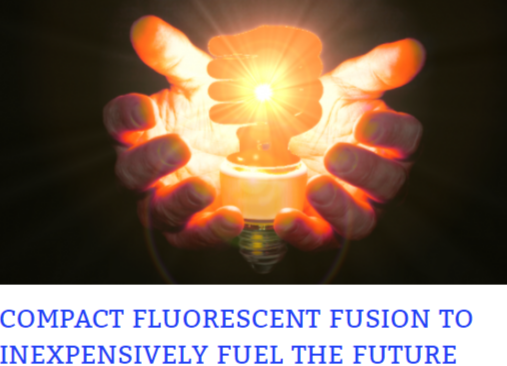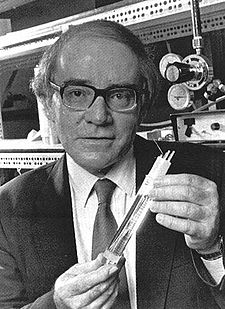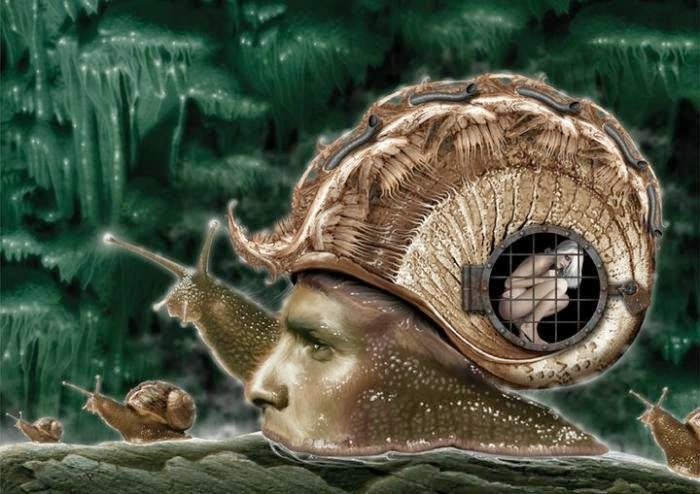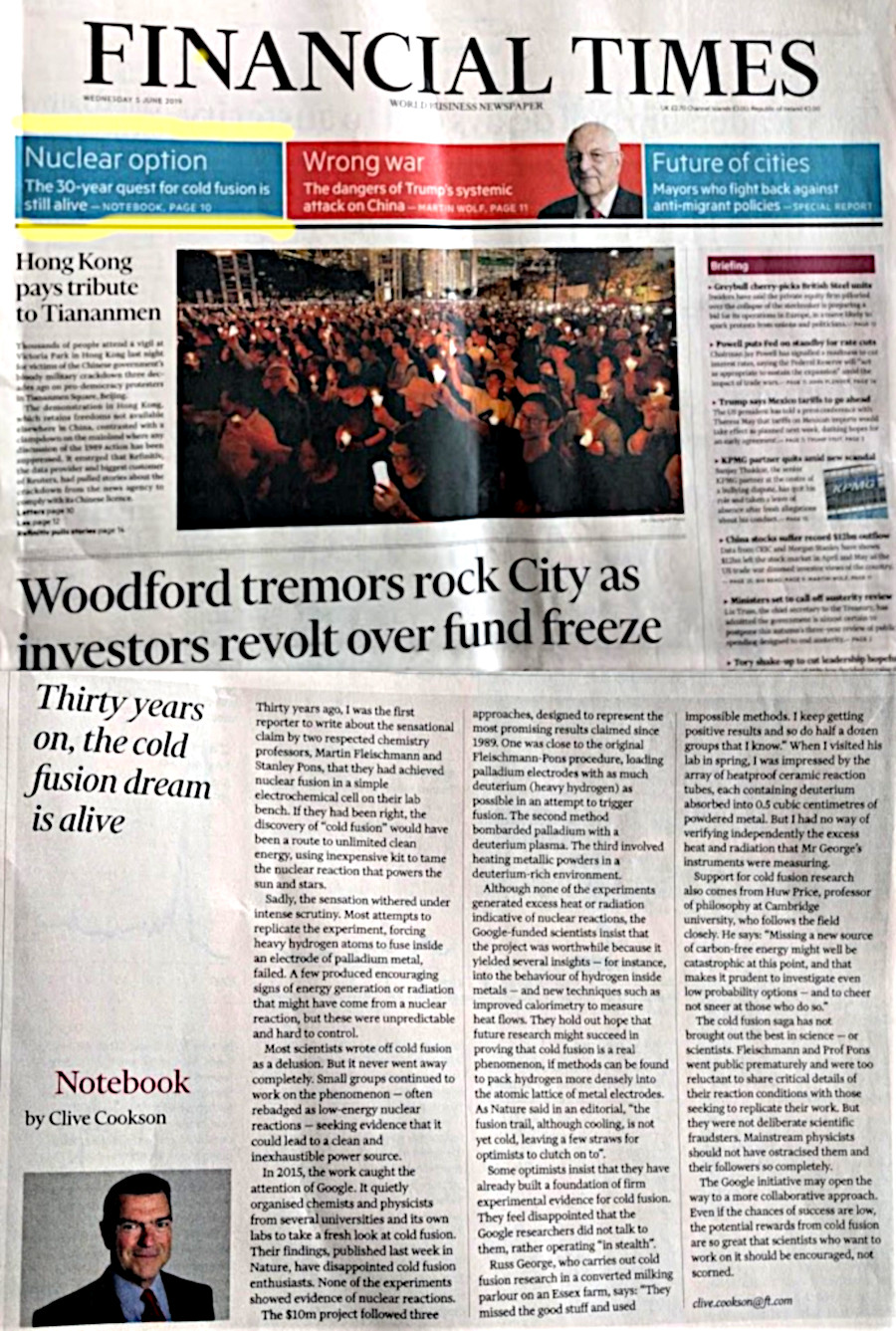
Cold Fusion Alive And Well
Cold Fusion, as revealed by famed South-Hampton Professor 30 years ago, is alive and well today in London
Given its transformational nature, the field lives with plenty of debate
While controversy, foisted upon the field, has scared off most researchers, not all
Like Apple Computer’s meme, It Just Works
A few weeks ago I was happy to host Financial Times Science and Business writer Clive Cookson in his visit to our modest Atom-Ecology laboratory. While technically in London, just barely, we are housed in an old milking barn in the barley fields of Essex. (Our local version of a Silicon Valley inventors garage.) Over the past few months, we have been entertaining a stream of visitors from around the world who have requested to view our working cold fusion experiments, these have included leading academics, UK government officials, and industry leaders.
Clive was a perfect gentleman and a well-informed man in the field. As it happens his father was a friend of and respected the late Prof. Martin Fleischmann, father of Cold Fusion. He told us he had long followed the topic and while not an expert in exotic nuclear physics, was surely convinced of the high caliber of the science of those in the field. Today Clive writes in the Financial Times about the discovery of cold fusion and current events.
If they (Fleischmann and Pons) had been right, the discovery of “cold fusion” would have been a route to unlimited clean energy, using inexpensive kit to tame the nuclear reaction that powers the sun and stars.”
30 years and counting
I have worked in the field for many years, perhaps too many years. It all began by being on the scene in the Electric Power Research Institute in Palo Alto on the day after the March 1989 announcement of cold fusion that took place in Salt Lake City Utah. That morning as I left my office and found my way down the hall to my regular coffee break room, there was a scene I will never forget.
The coffee room had been taken over by the nuclear engineers and scientists at the institute, and they had set up a large screen TV with a videotape of the previous day’s press conference from Utah. Already that press conference was being rebroadcast around the world in what would become, in the history of television, an event that drew a larger viewing audience than mans first steps upon the moon.
As I entered the coffee room I was asked to put my thumb up on the TV screen where the image of Fleischmann’s partner, Dr. Stanley Pons, Chairman of the Department of Chemistry at the University of Utah, was holding the very experimental test tube in which cold fusion was born. The width of my thumbnail, along with all the other men in the room, was being measured so as to give a scale to the apparatus that Pons held in his hand with his thumbnail visible.
This gave the engineers the ability to immediately reverse engineer the device which they did as was seen the next day at coffee when the experiment schematics were presented. Within a few days, the EPRI replication was in operation in two labs at neighboring Stanford University. The result, It Just Worked!
Nature Quirks
A week ago the Journal Nature published a paper by a team of Google-funded researchers who failed to make cold fusion work. They claim that the spectacular sum of $10 million USD has been spent in hundreds of attempts. The peer-reviewed paper is but part of this latest Nature treatment of cold fusion, the real punch as delivered by Nature is in the quite mind-boggling and presumptuous editorials. One must keep in mind that since the announcement of cold fusion 30 years ago, Nature has done everything in its considerable power to give cold fusion the cold shoulder.
The authors of the paper in Nature make a rather frank statement that they were unable to achieve the minimum conditions to produce ‘cold fusion’ that has been widely publicized by Fleischmann and many others. There are more than 1000 papers documenting success in the field of cold fusion over the past 30 years. One has to be very determined to not find them, such as failing to use Google.
At times I think that living in the Journal Nature’s version of reality is like being a snail on a slope. Living inside the 60’s Russian Sci-Fi novel by the Strugatsky brothers. Trapped between true mysteries and beauty of the universe and the Directorate of approved thought. A tale of science fiction and science reality.
Past and Present
I myself have given many invited papers showing cold fusion heat, helium, and other profound nuclear effects at conferences of the American Nuclear Society, American Physical Society, Ultrasound and Electron Microscopy Societies, and of course, many of the fields own cold fusion conference series. I’ve also taken my experiments on the road on multiple occasions to the world’s top national nuclear laboratories in the USA, Japan, and Europe.

Clive Cookson of the Financial Times because of his father’s friendship with Fleischmann got the ‘scoop’ and was the first reporter to write of the cold fusion discovery 30 years ago.
Clive Cookson has today presented his report in the Financial Times of London on the most recent Nature materials. You can read it by following this link. He points out “The $10m project followed three approaches, designed to represent the most promising results claimed since 1989.
One was close to the original Fleischmann-Pons procedure, loading palladium electrodes with as much deuterium (heavy hydrogen) as possible in an attempt to trigger fusion. The second method bombarded palladium with a deuterium plasma. The third involved heating metallic powders in a deuterium-rich environment.” Apparently, the scientists performing the work weren’t very good a-Googling for the recipes that abound on how to achieve success as all of their experiments failed.
Clive ends his report saying,
“The Google initiative may open the way to a more collaborative approach. Even if the chances of success are low, the potential rewards from cold fusion are so great that scientists who want to work on it should be encouraged, not scorned.”
Help from the Father of HOT fusion
I am delighted to see that two of the three approaches mentioned in this Google Nature treatment are those that I have considerable expertise with. My deuterium plasma experiments, glow discharge is a better description, of more than 20 years ago were very dramatic in terms of results. Those results brought to me, in less than 24 hours, a personal phone call from the famed Edward Teller, father of the hydrogen bomb.
Teller had been told of my findings by my friend who was in management at Lawrence Livermore Labs and who had on the day of my experiments helped me calculate my radiation dose. He rang me up the very next day introducing himself and inviting me, in his marvelous Dr. Strangelove eastern European accent, to come and talk with him at his Stanford office, I was living in Palo Alto at the time. He had learned about my results from a friend at Lawrence Livermore National Laboratory who I had consulted with having been in some fear for my health from the profound results I had observed in a cold fusion experiment no more complicated or expensive than an ordinary light bulb.
Teller and I developed a friendship as he mused that my simply being alive in the face of the data I had collected, proved that what I had produced was not ordinary fusion, the radiation from which would have promptly killed me. Instead, he revealed to me that he had ideas on what my strange radiation was, he called it ‘mischugenon’ radiation, ‘crazy’ radiation that acted in some ways like neutrons. But the enormous flux observed was clearly ‘crazy radiation,’ as it had done me no harm. Here’s a link to a more detailed account.
These days
The second of the Google/Nature approaches is described as being deuterium (heavy hydrogen) mixed with metal powders and simply heated to initiate the cold fusion reactions. This is my present major focus and that which is performing fantastically here in our simple lab. That lab, by the way, belongs to dear friends who are working on another more conventional chemical engineering where aluminium waste is converted into hydrogen gas that presently runs a small electrical generator. Eventually, that green technology may become a big item for our world that is seeking to develop a hydrogen-fueled economy.
My friends, Alan and Martin are old guys like me, we are all into our retirement years. They offered me a bit of their Ecalox laboratory bench space to do my Edisonian experiments in cold fusion that I had been wanting to try for some time. Their hydrogen fuel economy experiments occupy the majority of the lab. What more could one ask but have friends as collaborators who are always willing to lend a hand whenever needed.
Everywhere on this blog of mine, you can find reports on my work in the field past and present. A bright future for cold fusion is surely very near to hand and that will be the delivery of practical cold fusion technologies, incredibly clean, inexpensive, and simple devices to do everything from boil your kettle to powering your next round the world flight.
Atom-Ecology
My world of cold fusion these days is packaged in my company and meme which I call Atom-Ecology. This comes from being more of an ocean/plankton ecologist working in nature than a nuclear scientist. Fortunately, my father was a nuclear scientist and it was at his knee, I learned as a young child how to operate a Geiger counter and understand the inner workings of atoms. When cold fusion showed up in my coffee break room, my father’s genes suddenly fired up in me.
I have, in my 30 years of working on cold fusion, come to understand that it is a common part of very unusual conditions/ecologies found in nature. Nature it seems to me prefers complexity but not so complex as to be impossible to observe and recreate if one is a patient observour and experimentalist.

Cold fusion heating can be engineered into nothing more complex or exotic than a light bulb. Click to read more
Having twice before in these 30 years of cold fusion created companies which spent millions in pursuit of the elusive cold fusion I am now convinced that finally, the time is right, not too early, not too late, but just right for this Goldilocks’ story to be completed.
Atom-Ecology is presently working on its first, Series A, investment offering. With the finance in hand, we believe we can assemble the engineering team to allow us to, within 2-3 years, deliver practical cold fusion heating devices ready for mass production.



Dear Russ,
You write about Cold Fusion always so beautifully and passionately. Obviously you have found a direction to succeed now and I desperately hope you are right. I wish you all the luck, wisdom and good health for the coming 3 years. Let the New Fire be lid!
Greetings and regards,
Gerard McEk